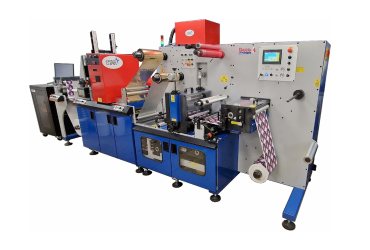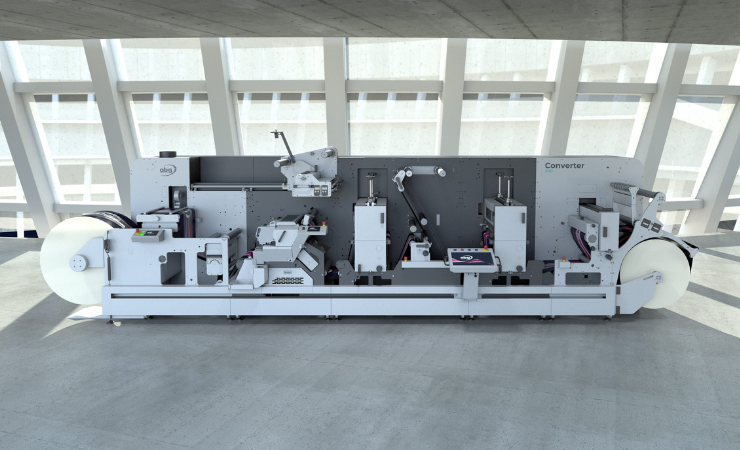Development of digital converting systems has been stepped up to meet the increased capabilities of the latest digital presses, and there are options for different levels of investment.
All suppliers of digital converting systems are most definitely not alike. At the upper end, there is AB Graphic and GM (Grafisk Maskinfabrik), which have longstanding relationships with HP and Xeikon respectively, and so often come into the frame as a matter of course when these major digital press vendors are making a sale.
At the other end of the spectrum are companies such as Daco Solutions, Focus Label Machinery and Easily Converted, all of which sell admirable converting systems for both narrow web flexo and digital print output, more modestly pitched and priced for smaller printers and converters.
Nevertheless, there is at times some crossover, says Mark Laurence, sales manager at Daco Solutions. ‘We sell digital converting lines so if people with an HP or Xeikon need a converting line for die cutting, embellishment etc, we do all of that. It’s a strong area but it’s a weak one too, because HP are tied up with AB Graphic, and Xeikon are tied up with GM. We have sold quite a few converting lines to Konica Minolta users but Focus Label (which is a Konica Minolta distributor) sells those converting lines too.’
There has been massive development in even the less sophisticated semi rotary converting lines in recent times, says Mr Laurence, with many now capable of operating at almost 100m/min. Nevertheless, it is clear that a company such as Daco Solutions is not really competing with AB Graphic and GM.
‘We are only going to a certain level of finishing, whereas ABG will do a massive converting line,’ said Mr Laurence. ‘The advantage of the smaller companies though is lower costs, including service costs. We are smaller and more flexible a lot of the time and increasingly we are going into smaller label converters with the features they want on the machine: we do digital converting, flexo, varnishing, cold foil embellishments, braille. When you get into hot foiling and some of the tactile finishes though, that’s when we walk away. To put that sort of development in there is not affordable for us.’
Premium option
At the other end of the market, AB Graphic sees flexo as very much a ‘prime part of the market’, according to Claire Fenton, the firm’s marketing manager. She points out that the relationship between ABG and HP has been going for 20 years now, but that ABG itself is a 70-year-old business.
Digital converting systems such as the ABG Digicon are unquestionably considered top of the range by many printers and converters, and anecdotally are often cited as being the finishing equipment used in successful FlexoTech Awards entries.
‘We make good quality equipment that lasts a long time,’ says Ms Fenton. ‘The market h
as changed in the last 10 to 15 years, with lots more Chinese products around, but for us, it’s just about offering solid converting products. We are premium, and therefore more expensive, but the machines are all designed and built within ABG factories – nothing is outsourced and the longevity of ABG machinery speaks for itself.’
For those unable to stretch their budget to a Digicon, there is the entry level DigiLite, available in rotary and semi rotary configurations, and with a wide range of converting options, including varnishing, die cutting, cold foiling and lamination, at speeds of up to 80 m/min.
The Digicon Series 3 is the company’s flagship machine, capable of running at 180m/min, modular and so configurable with a wide range of converting options. These include laminating, die cutting, flatbed screen printing, a hot foil and embossing module, and digital embellishment. Most recently, ABG announced the fourth generation of its Converter system, which is built on the same platform as the Digicon. Again, highly modular and therefore customisable, the system can run at up to 250m/min and has built in flexo technology.

Daco Solutions’ DF350SR, as installed at Arc Labels
Perhaps the clearest indicator of the scale of ambition between the bigger and the smaller companies in the digital converting sector, however, comes not in hardware, but in software and connectivity. ABG Connect is being rolled out and is described by ABG as a ‘complete revolution for the labels and packaging market’. Digital transformation is well underway, and ABG Connect helps to bring automation to the finishing line, as well as integrating with MIS software to automatically share live job data that enables accurate production reporting, directly from the converting line.
‘We’re doing a lot of work with CERM, so that their MIS can talk to our machines. ABG Connect is compatible with any MIS but has the highest level of interaction with CERM currently,’ said Ms Fenton.
It represents a level of digitalisation, and indeed cost, that many smaller flexo printers and converters might baulk at, but as we have seen, flexo printers considering digital converting system options can very much choose horses for courses.










